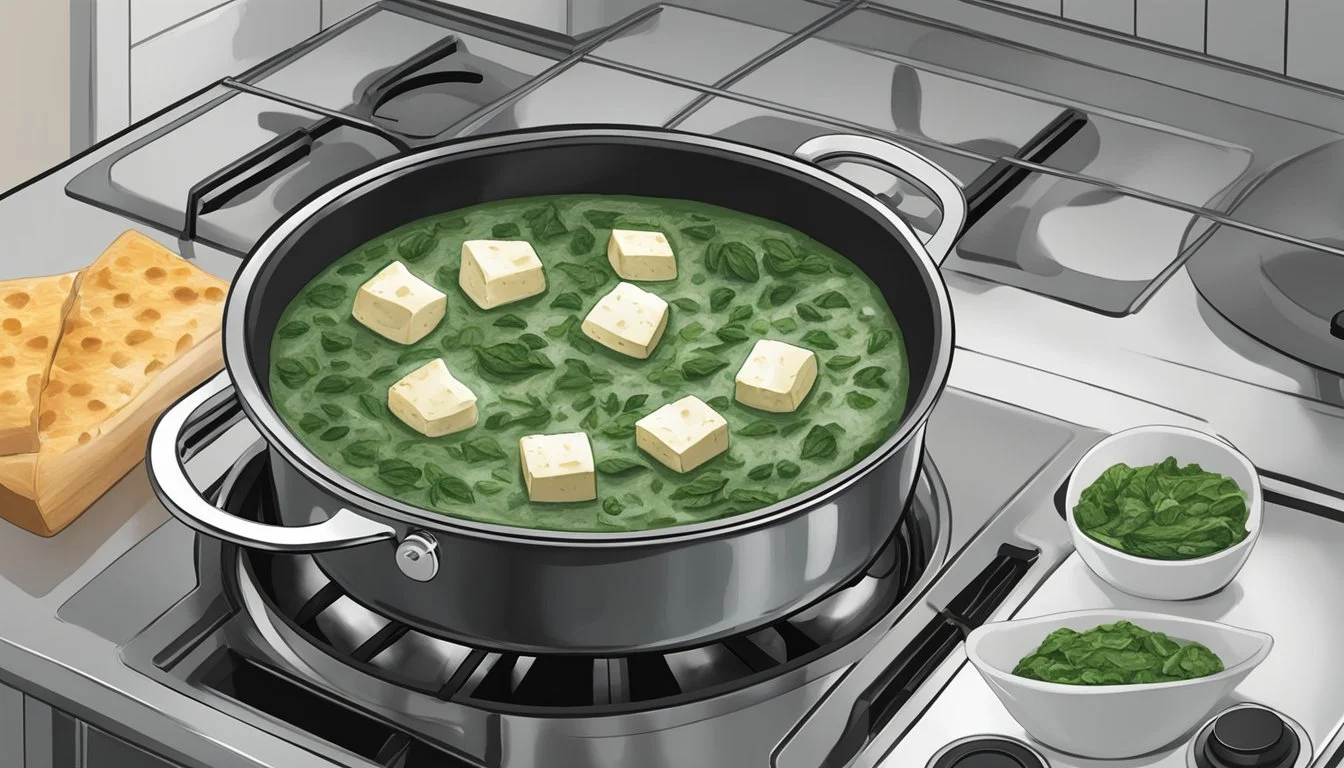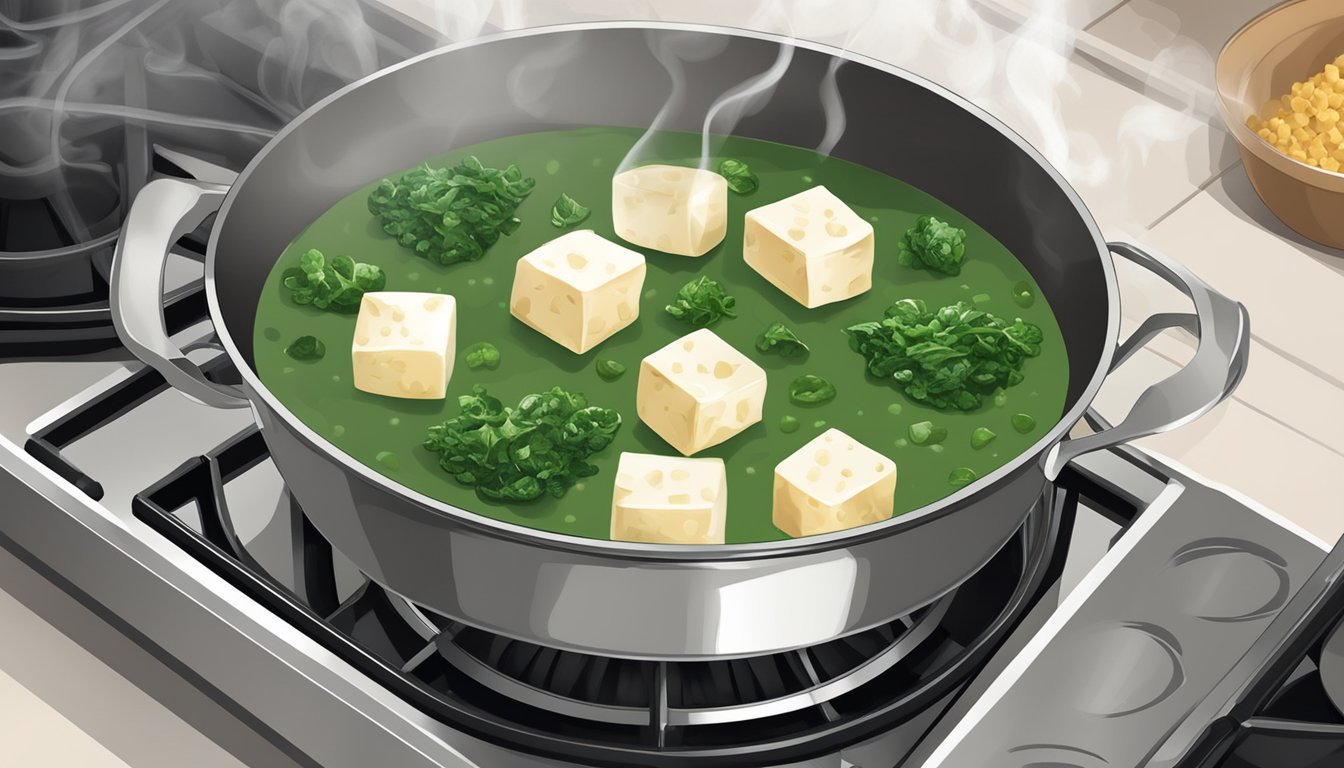Best Way to Reheat Saag Paneer
Ensuring Creamy Spinach and Soft Paneer Every Time
Saag paneer, a classic Indian dish, brings together the creaminess of spinach (What wine goes well with spinach?) puree with the softness of paneer cheese. When reheated correctly, this dish retains the distinct textures that make it a culinary delight. Achieving the right balance between a creamy spinach mixture and tender paneer chunks requires attention to detail and proper reheating techniques.
Reheating saag paneer so that it maintains its optimal consistency can be a challenge, particularly because the paneer tends to become hard and rubbery, while the spinach can lose its smooth texture if overcooked. It is imperative to approach the reheating process in a way that preserves the integrity of both components. The key lies in gentle and even reheating, allowing the flavors to blend together without compromising on the dish's original quality.
To ensure that both the spinach and paneer maintain their best qualities upon reheating, one must use methods that avoid direct high heat and instead opt for a more controlled approach. This prevents the delicate paneer from losing its moisture and becoming tough, and it also allows the spinach base to remain creamy. Whether using a stovetop, oven, or microwave, it is possible to revive leftover saag paneer to a state that rivals its freshly cooked taste.
Understanding Saag Paneer
Saag Paneer is a beloved dish in Indian cuisine, showcasing creamy spinach and soft cheese. It delicately balances rich flavors and textures, requiring an understanding of its makeup and roots.
Ingredients Breakdown
Cheese: Paneer is an Indian cottage cheese that is mild in flavor and dense in texture, often cubed and added to dishes.
Spinach: The 'Saag' in Saag Paneer generally refers to spinach, although it can sometimes represent other leafy greens.
Leafy Greens: Mustard greens are frequently mixed with spinach to create a more complex flavor profile.
Aromatics & Spices: Sauteed onion, minced garlic, and grated ginger form the flavor foundation, with coriander, cumin, turmeric, and garam masala adding depth.
Fats: Ghee (clarified butter) is commonly used for sautéing, providing a rich, nutty flavor.
Cultural Significance
Saag Paneer holds a special place in Punjabi and wider Indian cuisine as a quintessential vegetarian dish. Its combination of spinach and paneer, both nutritious and fulfilling, reflects the emphasis on balanced meals in Indian culinary traditions. The dish also exemplifies the innovative use of spices like cumin and coriander, and the penchant for slow-cooking techniques, to achieve harmonious flavors.
Preparing for Reheating
Proper initial cooking and storage techniques are essential for reheating saag paneer in a way that maintains the creamy texture of the spinach and the softness of the paneer. Heeding these steps helps ensure that the dish remains as close to its original state as possible.
Initial Cooking Tips
When cooking saag paneer for the first time, one should start with fresh spinach to ensure a vibrant green color and creamy consistency upon reheating. Adding cream during the cooking process can help retain the delicate nature of the dish. It's important to cook spices such as turmeric, cumin, and coriander thoroughly to bring out their flavors and meld them seamlessly with the spinach and cheese.
Sauté spinach until wilted and then blend to desired consistency before returning to the pan.
Integrate the spices early, allowing them to become aromatic.
Gently fold the paneer into the spinach mixture to avoid breaking the cheese cubes.
Storage Techniques
Saag paneer should be cooled to room temperature before storage to prevent bacterial growth. Once cool, placing the saag paneer in an airtight container is optimal for both refrigerator and freezer storage. The airtight container preserves the dish's moisture and prevents the absorption of odors.
Use a shallow, wide container to promote even cooling and reheating.
Store in the refrigerator if planning to consume within 2-3 days.
For longer storage, place in the freezer, where saag paneer can last for up to a month.
By following these methods, the saag paneer is well-preserved, making it simpler to achieve a desirable texture and taste upon reheating.
Reheating Methods
When reheating saag paneer, maintaining the creamy texture of the spinach and the softness of the paneer is crucial. Selecting the appropriate method can help preserve these qualities.
Microwave Method
To use the microwave, transfer the saag paneer to a microwave-safe dish. Sprinkle a few drops of water or milk to keep it moist and cover it with a microwave-safe lid or wrap to promote even heating and retain moisture. Microwave on medium power in 30-second intervals, stirring between each interval to ensure even reheating.
Stovetop Method
Reheating saag paneer on the stovetop is effective for retaining its creamy consistency. Pour the leftovers into a pan and reheat gently over low to medium heat. Stir occasionally to prevent sticking and if it appears dry, add a small amount of water or cream. This method allows for close monitoring of the texture to prevent overcooking.
Oven Method
Preheat the oven to 350°F (175°C). Spread the saag paneer in an oven-safe dish and add a few tablespoons of water or cream for moisture. Cover the dish with foil to trap steam and reheat for about 10-15 minutes, or until warm throughout. This method is suitable for larger quantities but may not preserve the paneer’s softness as well as other methods.
Instant Pot Method
An Instant Pot can reheat saag paneer efficiently while keeping it creamy. Add the leftovers to the Instant Pot with a splash of water or milk for added moisture. Use the 'Keep Warm' setting if available or reheat on a low-pressure setting for a few minutes. Release pressure naturally to avoid the paneer becoming too firm.
Troubleshooting Common Issues
When reheating Saag Paneer, one may encounter issues such as the spinach mixture separating or the paneer losing its desired soft texture. This section addresses these common complications with effective solutions.
Preventing Separation
To avoid the creamy spinach base of Saag Paneer from separating, one should gently reheat the dish on a low heat setting. Incorporating a small amount of cream or full-fat yogurt can help in maintaining the emulsion. Here's a step-by-step guide:
Reheat Slowly: Start on a low heat, stirring occasionally.
Add Dairy: If signs of separation are noticed, stir in a tablespoon of cream or yogurt.
Avoid Boiling: Keep the temperature low to prevent boiling, which can cause separation.
Maintaining Texture
Paneer should remain soft and succulent after reheating. To preserve its texture, avoid high heats and prolonged cooking times. Follow these tips:
Gentle Heat: Use a low to medium heat to warm the paneer through without toughening it.
Short Duration: Limit the heating time to just a few minutes.
Stir Carefully: Stir the paneer pieces gently to prevent them from breaking.
Heat the paneer separately in a pan using minimal butter or oil, then combine it with the spinach mixture towards the end of the reheating process to retain its softness. This technique ensures the paneer remains tender and the creamy spinach sauce stays unified, resulting in reheated Saag Paneer that is as enjoyable as when it was freshly made.
Alternative Reheating Tips
When reheating Saag Paneer, one should maintain the creamy consistency of the spinach and the softness of the paneer. To achieve this, different methods can be required, especially when dealing with vegan versions or alternative cheese options.
Reheating Vegan Saag Paneer
For vegan Saag Paneer, which usually substitutes paneer with tofu and dairy with coconut milk or other plant-based options, reheating needs gentle care. They should use lower temperatures to prevent the tofu from becoming rubbery. The spinach mixture can be heated on the stove, stirring frequently to maintain its creamy texture. It's advisable to add a splash of coconut milk while reheating to keep the moisture level consistent.
Using Different Types of Cheese
When Saag Paneer is made with different types of cheese, such as softer cheeses like ricotta or firmer ones like halloumi, reheating techniques may vary:
For softer cheese varieties:
Reheat on the stove over low heat.
Stir gently to avoid breaking the cheese into the spinach gravy.
For firmer cheese types:
Sauté lightly before adding to the spinach mixture, if not already combined.
Use a medium heat to maintain the texture without drying it out.
In both cases, watching closely and avoiding microwaving is key, as it can lead to uneven heating and texture changes that don't do justice to the dish.
Serving Suggestions
When reheating saag paneer, the aim is to maintain the creamy texture of the spinach puree and the softness of the paneer. Choosing the right accompaniments and presenting the dish well can enhance the overall dining experience.
Accompaniments
Naan: A classic pairing, the soft and slightly chewy texture of naan soaks up the creamy spinach gravy well.
Rice: Basmati rice serves as a mild and fluffy bed, complementing the rich flavors of saag paneer without overwhelming it.
Presentation Tips
Contrast & Color: Using a white dish can make the vibrant green of the spinach puree stand out, providing an appealing contrast.
Garnishing: A sprinkle of mild spices or herbs on top can add to the visual appeal and introduce an aromatic element to the meal.
Conclusion
When reheating Saag Paneer, careful attention ensures that the creamy spinach is warmed through without losing its texture, and the paneer cheese remains soft and succulent. Below is a concise guide to maintaining the quality of this beloved dish:
Microwave: For a quick method, place Saag Paneer in a microwave-safe dish and cover it with a lid. Heat on medium power in increments of 30 seconds, stirring in between to ensure even warmth.
Stovetop: Gently warm the dish in a saucepan over low heat. Add a splash of water or cream if the spinach mixture seems too thick. Stir frequently to prevent sticking, until the curry is sufficiently heated.
Oven: Preheat the oven to 350°F (175°C). Transfer the Saag Paneer to an oven-safe dish, cover with foil, and heat for 10-15 minutes. This method works well for larger quantities and keeps the paneer tender.
For both Sarson Ka Saag and Palak Paneer, one can apply these reheating techniques to preserve the lushness of the greens and the integrity of the paneer. Patience is key; rushing at high temperatures can detrimentally alter the texture and flavor.
Remember to store leftovers properly in the refrigerator, as this influences how well the dish reheats. A well-preserved Saag Paneer can offer a delightful meal experience even the next day, full of rich flavors and a comforting, creamy consistency.






